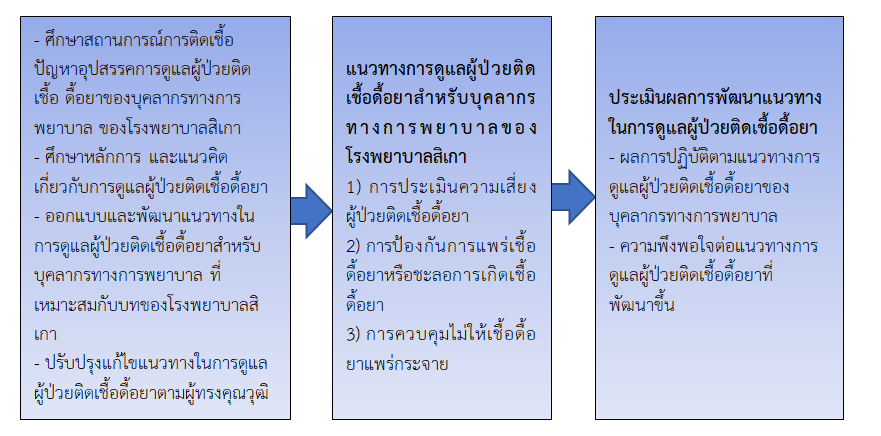Infection Situation, Antimicrobial Susceptibility Trends, and Guidelines for Caring Patients with Drug-Resistant Infections for Nurses at Sikao Hospital, Trang Province
Keywords:
thaiAbstract
The purposes of this research from Trang's Sikao hospital were to: 1) study infection, trends, and antimicrobial susceptibility in treating patients, as well as current guidelines for personnel in treating drug-resistant infectious patients, 2) develop new guidelines for treatment of patients with drug-resistant infections, and 3) evaluate the developed guidelines. This study design was a mixed method research. Staffs who involved in treatment of 40 drug-resistant infectious patients were recruited, and 293 reports of examination results were studied. Data was collected by in-depth interview questionnaire, opinion evaluation, and practice evaluation form. All data were analyzed by frequency, percentage, standard deviation, chi-square test, and content analysis.
The study results showed that most of the patients over 60 years of age who nwere admitted to Sikao Hospital from 2017–2020 had pathogens in their urine and blood. The top five pathogens that caused infections were E.coli, S.aureus, K.pneumoniae, P.aeruginosa, and E.faecalis (18.08%, 8.19%, 7.17%, 6.48% and 5.12%, respectively). The E.coli ESBL level of infection was at 3.41%. Multidrug resistance (MDR) was found at 4.44%, and E.coli susceptibility to the most commonly used antimicrobials (Ceftriazone) decreased from 75% to 41.7%. The use of new guidelines in treating patients with AMR for our target group was efficient at 95.37 percent. Overall satisfaction with this new approach was at a high level (88.8%). The scores of satisfactions towards the use of the guidelines were also at a high level.
Recommendations; The development of a surveillance system for drug-resistant illnesses should be supported by the infection prevention and control committee in hospitals. keep an eye on the infection status and the antimicrobial sensitivity findings
References
กมลวิช เลาประสพวัฒนา. (2556). โรคติดเชื้อในโรงพยาบาล.สงขลา :ชาญเมืองการพิมพ์
กำธร มาลาธรรม,วีรวัฒน์ มโนสุทธิ และคณะ.(2562).การป้องกันการติดเชื้อดื้อยาต้านจุลชีพใน
โรงพยาบาล:สำนักพิมพ์อักษรกราฟฟิคแอนดีไซน์
ฉัตรชัย รอดกระต่าย และฉันทนา กิ่มเทิ้ง. (2558). ความชุกของเชื้อแบคทีเรียดื้อยาต้านจุลชีพใน
โรงพยาบาลอุทัยธานี.ปริญญานิพนธ์ (เทคนิคการแพทย์ )คณะเทคนิคการแพทย์
มหาวิทยาลัยขอนแก่น
ชุติมาภรณ์ ไชยสงค์, พริยา ติยาภักดิ์, และคณะ. (2561). ความสัมพันธ์ของปริมาณการใช้ยาปฏิชีวนะ
และการดื้อยาปฏิชีวนะในโรงพยาบาลมหาสารคาม วารสารเภสัชอีสาน ปีที่ 15 ฉบับที่ 2 เม.ย.-มิ.ย.
นิธิมา สุ่มประดิษฐ์, ศิริตรี สุทธจิตต์, และคณะ. (2558). ภูมิทัศน์ ของสถานการณ์และการจดัการการดื้อ
ยาต้านจลุชีพในประเทศไทย :สำนักพิมพ์อักษรกราฟฟิก
บุญญรัตน์ รัตนประภา.(2562).การพัฒนาระบบการป้องกันและควบคุมการแพร่กระจายเชื้อดื้อยาควบคุม
พิเศษโรงพยาบาลศรีสังวรสุโขทัย สืบค้นจาก http://203.157.71.172/academic/web/site/
proceeding?event_id=1&page=research (2 ก.พ.64)
ปิยะดา ไทยราช. (2561). สถานการณ์เชื้อก่อโรคที่พบบอยู่และแนวโน้มอุบัติการณ์การดื้อต่อยาปฏิชีวนะ
ของเชื้อก่อโรคแต่ละชนิด ในผู้ป่วยเด็กโรงพยาบาลสิชล จังหวัด นครศรีธรรมราช วารสารวิชาการ
แพทย์เขต 11 ปี ที่32 ฉบับที่ 3 ก.ค.-ก.ย.2561.
ประจวบ ทองเจริญ, วันชัย มุ้งตุ้ยและอะเคื้อ อุณหเลขกะ. (2558). ผลการใช้กลวิธีหลากหลายต่อการ
ปฏิบัติของบุคลากรสุขภาพในการป้องกันการติดเชื้อแบคทีเรียดื้อยาหลายขนาน. สืบค้นจาก
https://www.tci-thaijo.org (2 กุมภาพันธ์2564).
พัชรินทร ญาติรักษ.์(2559). สถานการณ์การติดเชื้อแบคทีเรียในกระแสเลือด (Bacterimia).
วารสารวิชาการแพทย์ เขต 11 ปี ที่ 30 ฉบับที่ 1 ม.ค. - มี.ค. 2556
วรรษมน จันทรเบญจกุล , สุวพร อนุกูลเรืองกิตติ์ และคณะ. (2562). drug –resistant organisms in
pediatrics : diagnosis and treatment : กรุงเทพฯ แอคทีฟ พริ้นท์
สถาบันวิจัยวิทยาศาสตร์การแพทย์. (2560). คู่มือมาตรฐานห้องปฏิบัติการจุลชีววิทยาทางการแพทย์และ
สาธารณสุข.กรุงเทพฯ : บริษัท เท็กซ์แอนด์เจอร์นัล พับลิเคชั่น จำกัด
สุวรรณชัย วัฒนายิ่งเจริญชัย และอภิชาต วัชรพันธุ์. (2563). แนวปฏิบัติเพื่อป้องกันและควบคุมการติด
เชื้อในโรงพยาบาล.กรุงเทพฯ : อักษรกราฟฟิกแอนด์ดีไซน์
วัลลภา ช่างเจรจา.(2560). ผลการพัฒนาแนวปฏิบัติต่ออัตราการติดเชื้อดื้อยาที่ต้องควบคุมเป็นกรณี
พิเศษโรงพยาบาลบึงกาฬ. สืบค้นจาก https://www.bkh.moph.go.th.(2 กุมภาพันธ์2564).
วิไลลักษณ์ วงศ์จุลชาติ.การใช้กลวิธีหลากหลายเพื่อส่งเสริมการปฏิบัติตามแนวทางป้องกันและควบคุมการ
แพร่กระจายเชื้อดื้อยา ในโรงพยาบาลวชิระภูเก็ต วารสารวิชาการแพทย์เขต 11 ปีที่ 31 ฉบับที่ 3
ก.ค.- ก.ย. 2560
อะเคื้อ อุณหเลขกะ, สุชาดา เหลืองอาภาพงศ์ และจิตตาภรณ์ จิตรีเชื้อ.(2557).การพัฒนาแนวปฏิบัติใน
การป้องกันการแพร่กระจายเชื้อและการติดเชื้อดื้อยาที่เหมาะสมที่หออภิบาลผู้ป่วยของโรงพยาบาล
ระดับทุติภูมิและตติยภูมิ คณะพยาบาลศาสตร์ มหาวิทยาลัยเชียงใหม่
Akhe Unhalaka, Suchada Luangapapong and Chittaporn Chitrisaeng (2014).Developing appropriate drug-resistant infection prevention practices at hospital patients' pastoral Secondary and tertiary levels Faculty of Nursing, Chiang Mai University

Downloads
Published
How to Cite
Issue
Section
License
Copyright (c) 2023 Boromarajonani College of Nursing, Nakhon Si Thammarat

This work is licensed under a Creative Commons Attribution-NonCommercial-NoDerivatives 4.0 International License.
บทความที่ได้รับการตีพิมพ์เป็นลิขสิทธิ์ของ วิทยาลัยพยาบาลบรมราชชนนี นครศรีธรรมราช
ข้อความที่ปรากฏในบทความแต่ละเรื่องในวารสารวิชาการเล่มนี้เป็นความคิดเห็นส่วนตัวของผู้เขียนแต่ละท่านไม่เกี่ยวข้องกับวิทยาลัยพยาบาลบรมราชชนนี นครศรีธรรมราช และบุคคลากรท่านอื่น ๆ ในวิทยาลัยฯ แต่อย่างใด ความรับผิดชอบองค์ประกอบทั้งหมดของบทความแต่ละเรื่องเป็นของผู้เขียนแต่ละท่าน หากมีความผิดพลาดใดๆ ผู้เขียนแต่ละท่านจะรับผิดชอบบทความของตนเองแต่ผู้เดียว




